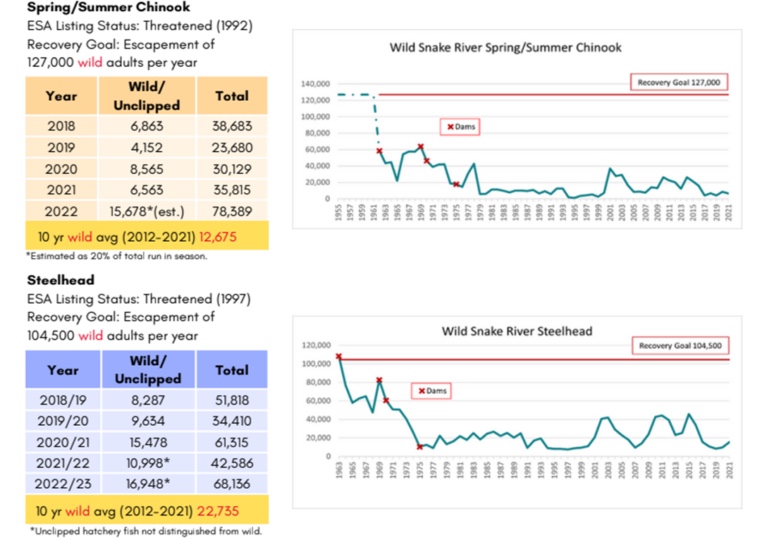forum
library
tutorial
contact

The Status of Wild Snake River Salmon and Steelhead;
Keeping Things in Perspective
by Tom Stuart and Dave Cannamela
Columbia Basin Bulletin, March 9, 2023
|
the film forum library tutorial contact |

|
The Status of Wild Snake River Salmon and Steelhead;
by Tom Stuart and Dave Cannamela
|
Snake River salmon and steelhe runs are on an extinction trajectory;
a trajectory precipitated by the completion of the four Lower Snake River dams.
 Recent reports (Columbia Basin Bulletin, February 2 and Eric Barker, Lewiston Tribune, February 5) claim that overall upriver returns to the Columbia basin are "on an upward swing." Such a claim ignores context and perspective.
Recent reports (Columbia Basin Bulletin, February 2 and Eric Barker, Lewiston Tribune, February 5) claim that overall upriver returns to the Columbia basin are "on an upward swing." Such a claim ignores context and perspective.
Regional recovery goals for wild Snake River spring/summer Chinook and steelhead are 127,000 and 104,500 adults annually (about 5% of historical returns), returning to the Clearwater, Salmon, Grand Ronde, Imnaha, Wallowa, Tucannon and other watersheds of northeast Oregon, central Idaho, and southeast Washington. The 2023 return forecast of 13,200 wild Snake River spring chinook, counted at Bonneville Dam, would deliver less than 10% of the recovery goal to Lower Granite Dam (where Snake R fish are counted). For wild steelhead of those watersheds, the 2022-23 wild adult estimated count at Lower Granite Dam was only about 15,500 fish, 14% of the recovery goal. (Note: a 2023-24 steelhead forecast is not yet available.)
The articles and source documents provide a detailed account of returns going back to the 1980's, with comments on the relative strength/performance of each year's run, but fail to focus on the "big picture," and an important message -- wild fish returning to northeast Oregon, southeast Washington, and central Idaho (Snake River runs) -- are on an extinction trajectory; a trajectory precipitated by the completion of the four Lower Snake River (LSR) dams. (Salmon originating below the LSR dams are not on the same dangerous trajectory.) Any "upward trend" must be compared to historical abundance and evaluated with current recovery goals.
Let's not confuse short-term upward "blips" with long-term declines or discount the big picture in salmon recovery. We doubt that anyone playing the stock market would invest in Snake River salmon, given the actual facts. Below find actual returns and wild portions for the past five years; note that, even in the best years (the upward blips) adult fish returns are less than 20% of recovery goals.
Hatchery returns: the 2023 forecast of spring chinook available for Idaho sport anglers is 3,200 salmon each, in the Clearwater and Rapid River fisheries. In the 1950s and 60s, even after the runs in the Snake basin had been reduced from millions to a few hundred thousand, sport fishers caught tens of thousands of wild fish each year, sustainably, in those places and in many others. Notably, wild fish runs prior to the lower Snake River dams provided fisheries that were extended in duration and spread out over a vast three-state geographical area -- the Snake River basin. More importantly, Native American Tribes were able to harvest ample supplies of salmon to fulfill their dietary (health), cultural, and spiritual needs, all while the US Government kept its treaty promises. All these benefits of abundant, harvestable, and sustainable salmon returns have been lost, and have not yet been restored to any meaningful level. Not to be overlooked are the ecological and economic benefits of healthy, sustainable runs: everything from Orca to insects and plants in the headwaters depend on salmon. Further, sport, commercial, and tribal fisheries provide livelihoods for many. Humans, along with many other species, are in the arch for which salmon are a keystone.
How are we doing with mitigating for the four LSR dams? Not well enough. Adult return goals from hatcheries operated under the Lower Snake River Compensation Plan have rarely, if ever, been met. Overall, the hatchery programs, although operated by well-meaning professionals, have failed to achieve their goal -- i.e., replacing lost fishing opportunities historically provided by abundant wild fish. The theory that hatcheries can mitigate has proved to be faulty; this is a challenge for political leaders of Oregon, Washington, and Idaho. Snake River Basin Tribes, sport fishers and others who depend on fisheries are the victims of a broken promise. The notion that in the Snake R basin, "We can have both abundant fish and dams," has proven impossible.
The clear truth is this: salmon populations, both wild and hatchery-derived, are not on an upward trend. They remain on an extinction path -- and we will not achieve recovery goals or restore sustainable fisheries in any abundance without giving the region a free-flowing Lower Snake River. Without salmon, steelhead, and Pacific lamprey, all NW citizens are diminished, and the entire ecosystem is impoverished.
learn more on topics covered in the film
see the video
read the script
learn the songs
discussion forum
